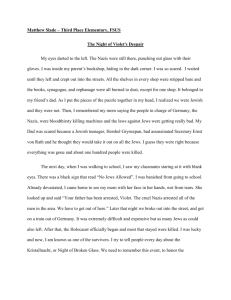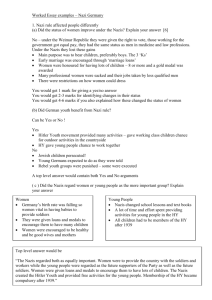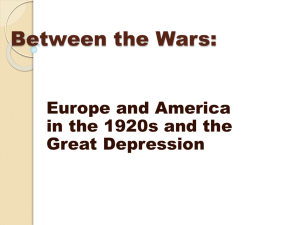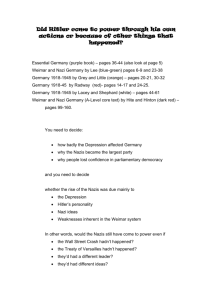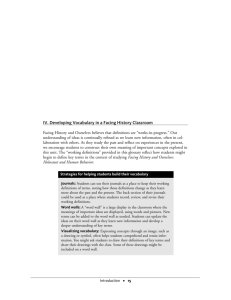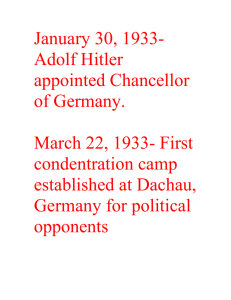here
advertisement
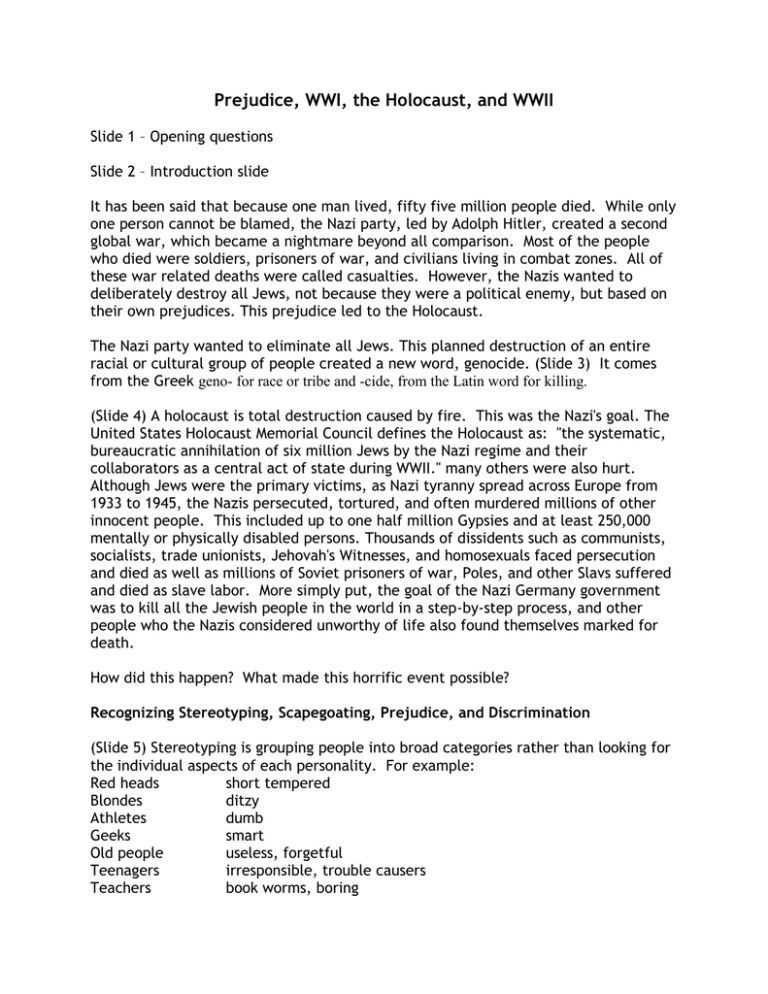
Prejudice, WWI, the Holocaust, and WWII Slide 1 – Opening questions Slide 2 – Introduction slide It has been said that because one man lived, fifty five million people died. While only one person cannot be blamed, the Nazi party, led by Adolph Hitler, created a second global war, which became a nightmare beyond all comparison. Most of the people who died were soldiers, prisoners of war, and civilians living in combat zones. All of these war related deaths were called casualties. However, the Nazis wanted to deliberately destroy all Jews, not because they were a political enemy, but based on their own prejudices. This prejudice led to the Holocaust. The Nazi party wanted to eliminate all Jews. This planned destruction of an entire racial or cultural group of people created a new word, genocide. (Slide 3) It comes from the Greek geno- for race or tribe and -cide, from the Latin word for killing. (Slide 4) A holocaust is total destruction caused by fire. This was the Nazi's goal. The United States Holocaust Memorial Council defines the Holocaust as: "the systematic, bureaucratic annihilation of six million Jews by the Nazi regime and their collaborators as a central act of state during WWII." many others were also hurt. Although Jews were the primary victims, as Nazi tyranny spread across Europe from 1933 to 1945, the Nazis persecuted, tortured, and often murdered millions of other innocent people. This included up to one half million Gypsies and at least 250,000 mentally or physically disabled persons. Thousands of dissidents such as communists, socialists, trade unionists, Jehovah's Witnesses, and homosexuals faced persecution and died as well as millions of Soviet prisoners of war, Poles, and other Slavs suffered and died as slave labor. More simply put, the goal of the Nazi Germany government was to kill all the Jewish people in the world in a step-by-step process, and other people who the Nazis considered unworthy of life also found themselves marked for death. How did this happen? What made this horrific event possible? Recognizing Stereotyping, Scapegoating, Prejudice, and Discrimination (Slide 5) Stereotyping is grouping people into broad categories rather than looking for the individual aspects of each personality. For example: Red heads short tempered Blondes ditzy Athletes dumb Geeks smart Old people useless, forgetful Teenagers irresponsible, trouble causers Teachers book worms, boring Parents nosy, power hungry, and occasionally dumb The Nazis used stereotyping to turn other Germans against Jewish German citizens. The Nazis portrayed the Jews with hateful posters depicting them as greedy with big noses and large hidden amounts of ill-gotten money, often in alliance with Russia. (Slide 6, the Eternal Jew) Due to the economic problems the Germans faced since losing World War I and the Great Depression, many people blamed the government for the problems they faced on a daily basis. The Nazis directed this anger and frustration away from their government and onto the Jews by blaming them for the country's economic problems. Blaming an innocent person or group of people for problems is called scapegoating. (slide 7) The Nazis turned the anger of the Germans onto the Jews thus making them the scapegoat for all of Germany's problems. This kept the peoples' anger directed away from the Nazi government that could not fulfill the promises made to the people. Remember that scapegoating does not have to be based on fact. As a totalitarian government which is a government whose political belief is on of absolute rule (slide 8). In this totalitarian government, the Nazis controlled everything, including information people received via radio and newspapers. This made it very easy for them to create or warp data into blaming the Jews. Prejudice is strong feelings of intolerance or hatred for another group or groups of people, often based on inaccurate or incorrect information about that group (slide 9). Many people in Germany and other countries of the time felt prejudice against the Jews for many reasons that didn't make sense and went farther back in time than they could even remember. Prejudice is often passed on from parent to child and usually has no basis in truth or reality. Think of the phrase "those people". This can mean any group, yet it rarely has a positive meaning. Think about hearing "Well, what can you expect from those people?" or "You know how those people are." All people experience prejudices of one kind or another, and the Nazis used this to turn the Germans against the Jews. It is important to remember most people feel prejudice of one kind or another, but acting on those feelings in any way that harms others is wrong. Discrimination is acting on prejudicial feelings. Discrimination is to exclude or abuse people without logical reasons. Discrimination is often based on a person's race, religion, nationality, or anything else that sets them apart from others (slide 10). The most obvious group in America is the Ku Klux Klan, but many other groups discriminate, just less obviously. In most developed and civilized countries today, discrimination is frowned upon if not illegal. Most people will fight to defend family and friends, yet most will not interfere if the victim is someone they do not know and they believe they will be in too much personal danger. Imagine being at the mall with a group of your friends. Someone you barely know, maybe you've only passed them in the hall at school, is being bullied at the mall. The gang of bullies is hurting this person and stealing this person's money. What would you do? (Pause for students' responses.) Now imagine it is your best friend or little brother or next door neighbor. What would you do now? This is what happened in Germany when Nazis attacked German Jews. Almost always people looked the other way rather than risk themselves by becoming involved. While we would all like to think we would have stood up and done the right thing, less than five percent of the German people helped those being persecuted. Why did the Germans and others around the world, including America, stand by and pretend not to know what was happening? Standing up for what is right is not always easy, especially when that thing is bigger and stronger. Most people backed down from the Nazis out of fear. This story helps make this clearer. "The Terrible Things" by Eve Bunting (slide 11) (slide 12) The clearing in the woods was home to the small forest creatures. The birds and squirrels shared the trees. The rabbits and porcupines shared the shade beneath the trees and the frogs and fish shared the cool brown waters of the forest pond. Until the day the Terrible Things came. (slide 13) Little Rabbit saw their terrible shadows before he saw them. They stopped at the edge of the clearing and their shadows blotted out the sun. (slide 14) “We have come for every creature with feathers on its back,” the Terrible Things thundered. “We don’t have feathers,” the frogs said. “Nor we,” said the squirrels. “Nor we,” said the porcupines. “Nor we,” said the rabbits. The little fish leaped from the water to show the shine of their scales, but the birds twittered nervously in the tops of the trees. Feathers! They rose in the air, then screamed away into the blue of the sky. (slide 15) But the Terrible Things had brought their terrible nets, and they flung them high and caught the birds and carried them away. The other forest creatures talked nervously among themselves. “Those birds were always noisy,” Old Porcupine said. “Good riddance, I say.” “There’s more room in the trees now,” the squirrels said. “Why did the Terrible Things want the birds?’ asked Little Rabbit. “What’s wrong with feathers?” “We mustn’t ask,” Big Rabbit said. “The Terrible Things don’t need a reason. Just be glad it wasn’t us they wanted.” (slide 16) Now there were no birds to sing in the clearing, but life went back almost as before. Until the day the Terrible Things came back. “We have come for every creature with bushy tails,” roared the Terrible Things. “We have no tails,” the frogs said. “Nor do we. Not real tails,” the porcupines said. The little fish jumped from the water to show the smooth shiny of their finned tails and the rabbits turned their rumps so the Terrible Things could see for themselves. “Our tails are round and furry,” they said. “By no means are they bushy.” (slide 17) The squirrels chattered their fear and ran high into the treetops, but the Terrible Things swung their terrible nets higher than the squirrels could run, and wider than the squirrels could leap and they caught them all and carried them away. (slide 18) “Those squirrels were greedy,” Big Rabbit said. “Always storing away things from themselves. Never sharing.” “But why did the Terrible Things take them away?” Little Rabbit asked. “Do the Terrible Things want the clearing for themselves?” “No. They have their own place,” Big Rabbit said. “But the Terrible Things don’t need a reason. Just mind your own business, Little Rabbit. We don’t want them mad at us.” Now there were no birds to sing or squirrels to chatter in the trees, but life in the clearing went on almost as before. Until the day the Terrible Things came again. (slide 19) Little Rabbit heard the rumble of their terrible voices. “We have come for every creature that swims,” the Terrible Things thundered. “Oh, we can’t swim,” the rabbits said quickly. “And we can’t swim,” the porcupines said. The frogs dove deep in the forest pool and ripples spiraled like corkscrews on the dark brown water. The little fish darted this way and that in the streaks of silver. But the Terrible Things threw their terrible nets down into the depths and they dragged up the dripping frogs and the shimmering fish and carried them away. (slide 20) “Why did the Terrible Things take them?” Little Rabbit asked. “What did the frogs and fish do to them? “Probably nothing,” Big Rabbit said. “But the Terrible Things don’t need a reason. Many creatures dislike frogs, lumpy, slimy things. And fish are so cold and unfriendly. They never talk to any of us.” Now there were no birds to sing, no squirrels to chatter, no frogs to croak, no fish to play in the forest pool. A nervous silence filled the clearing, but life went on almost as usual. Until the day the Terrible Things came back. Little Rabbit smelled their terrible smell before they came into sight. The rabbits and the porcupines looked all around, everywhere, except at each other. “We have come for every creature that sprouts quills,” the Terrible Things thundered. The rabbits stopped quivering. “We don’t have quills,” they said, fluffing their soft, white fur. (slide 21) The porcupines bristled with all their strength. But the Terrible Things covered them with their terrible nets, and the porcupines hung in them like flies in a spider’s web as the Terrible Things carried them away. “Those porcupines always were bad tempered,” Big Rabbit said shakily. “Prickly, sticky things!” This time Little Rabbit didn’t ask why. By now he knew that the Terrible Things did not need a reason. The Terrible Things had gone, but the smell still filled the clearing. “I liked it better when there were all kinds of creatures in our clearing,” he said. “And I think we should move. What if the Terrible Things come back?” “Nonsense,” said Big Rabbit. “Why should we move? This has always been our home. And the Terrible Things won’t come back. We are White Rabbits. It couldn’t happen to us.” (slide 22) As day followed day Little Rabbit thought Big Rabbit must be right. Until the day the Terrible Things came back. Little Rabbit saw the terrible gleam of their terrible eyes through the forest darkness. And he smelled the terrible smell. (slide 23) “We have come for any creature that is white,” the Terrible Things thundered. “There are no white creatures here but us,” Big Rabbit said. “We have come for you,” the Terrible Things said. The rabbits scampered in every direction. “Help!” they cried. “Somebody help!” But there was no one left to help. And the big circling nets dropped over them, and the Terrible Things carried them away. (slide 24) All but Little Rabbit, who was little enough to hide in a pile of rocks by the pond and was smart enough to stay so still that the Terrible Things thought he was a rock himself. When they had all gone, Little Rabbit crept into the middle of the empty clearing. “ I should have tried to help the other rabbits,” he thought. “If only we creatures had stuck together, it could have been different.” (slide 25) Sadly, Little Rabbit left the clearing. He’d go tell other forest creatures about the Terrible Things. He hoped someone would listen. Another example of this can be seen in the poem: “First They Came for the Jews” by Martin Niemoller First they came for the Jews And I did not speak out Because I was not a Jew. Then they came for the Communists And I did not speak out Because I was not a Communist. Then they came for the trade unionists And I did not speak out Because I was not a trade unionist. Then they came for me And there was no one left to speak out for me. Effects of WWI, which led to WWII Prejudice and fear caused the German citizens to blindly follow the Nazi government, but this did not happen overnight. It actually began following World War I. 1919 Germany sank into a serious economic depression following their loss in World War I. Germany not only lost in its attempt to take over parts of Europe, the rest of the world blamed Germany for having causing the war in the first place. The other war ravaged countries wanted Germany to pay for the war damages At the Paris Peace Conference, the Treaty of Versailles made Germany responsible for paying war damages. (Slide 26 shows Prime Minister Lloyd George, Italian foreign minister Giorgio Sonnino, French premier Georges Clemenceau, and American President Woodrow Wilson.) The German people lost all faith in their government and suffered from a shattered economy. Because of the cost of running a war, inflation rose so high that a fortune could not buy a pound of sugar or a bunch of carrots. Most people went through their lives' savings quickly and became desperate. Laborers went on strike, companies closed, and workers lost their jobs, as the government tried to handle the war debts. Two extreme plans came forward to solve these problems. One solution came from the Communist party who wanted Germany to become a satellite country of Russia. Under this plan the government would seize control of all property and businesses, and ideally, all workers would share in the wealth. The other solution came from the National Socialist party, the Nazis, led by Adolf Hitler. This political party promised to give every worker a job and food, war payments to other countries would stop, and restoration of the world prestige and military supremacy that Germany had known before WWI. He said he could do this by creating a master race of "pure Aryans", through the scientific belief of the time called eugenics, and a Third Reich, a state composed of all German speaking people who would rule the world. The people wanted to change their lives of poverty, and many backed the Nazi party based on the promises offered, very much like people today will vote for the political candidate who promises what they want to hear. 1924 (slide 27 Picture of European money) Other countries around the world objected to either group controlling Germany, so they came to the rescue of Germany and poured money into their economy. The economy improved, people returned to work, prices came down, and good times returned to Germany. While good for the German people, the Communists and Nazis found their political plans stalled. During this time, no one would really listen to or support either party or their messages against private businesses and the Jews. 1929 (slide 28 and 29 - People suffering from poverty due to the Great Depression) Unfortunately when the American stock market crashed in October 29, 1929, a worldwide depression resulted, and economies around the world collapses, including Germany’s. Money problems from one country always affect other countries because money has no borders and moves back and forth between countries all over the world. There were four stages of the Holocaust beginning in the early 1930s. At any time bureaucrats, government officials, Nazi Party members, and ordinary citizens could have chosen not to cooperate with the Nazi's plan, yet because the German legislature, under Nazi influence, legalized these actions, most people of the time felt they must follow them. Early 1930s (Slide 30 Pictures of Jewish ID cards) Stage one: Definition. In this stage the German government, being heavily influenced by the Nazis, began classifying German citizens as Jewish or Non Jewish. This was done through an irrational system that determined religion based on the religion of one’s grandparents. If someone had one or more Jewish grandparents, they would then be Jewish. This was determined through the religions listed on birth certificates and other government and church documents. The Nazis defined Judaism based on irrational pseudo-scientific belief that this was a genetic, not spiritual choice. This required all people defined as Jews to carry identity cards marked with a large “J”. By 1931 countless businesses and factories closed and five million Germans lost their jobs. With no jobs, no food, no heat, and in many cases, no homes, the Germans distrusted their government more than ever before. This brought the Communists and the Nazis back into popularity, and many joined both parties hoping change would improve their lives. The two parties fought each other and created so much confusion that the German government lost control. Many, fearing a Communist take over would mean a take over by Russia, viewed the Nazi party as "more German", thus making it possible for Hitler and the Nazi party to continue to gain power. Late 1932 (Slide 31 - Picture shows Nazi soldier hanging sign telling Germans to boycott Jewish owned businesses) Stage two: Expropriation During this stage the government seized Jewish businesses and property. Jews were forbidden to hold certain jobs, live in certain places, or have bank accounts. All Jews who worked for the government lost their jobs, universities fired professors, and Jews could no longer work in theaters, movies, arts, court systems, press, education, medicine, or law. Jewish owned or run businesses were also boycotted. The government easily completed this economic attack on the Jews because stage one created government rolls of the Jews. 1933 (Slide 32 - Nazi soldiers marching in parade formation) At this time the Nazi party took control of the German political system, declared themselves the only legal political party in Germany, and burned down part of the German parliament building, the Reichstag, destroying important documents and further disrupting the daily functioning of the country. As soon as Hitler took power, he intensified his campaign against the Jews. He first suspended all freedoms of speech, press, or assembly, making it easy for him to control all information received by the German people. Through anti-Semitic propaganda, he made the Jews scapegoats for all of Germany's problems, accusing them of being the internal enemy who caused inflation, the depression, and Germany's loss in WWI. This way Hitler distracted from his own failure to meet his promises to the people. While none of his accusations made sense, people joined the Nazi party in large numbers and began to act against German Jews, beginning the legal harassment that eventually led to the Holocaust. This is also when the Nazis began planning expanding Germany's boundaries as established by the Treaty of Versailles. Note the boundaries on the map. (Slide 33) 1934 (Slide 34 - Adolf Hitler) Hitler guaranteed his place as dictator of Germany with the “Night of the Long Knives” in which his private troops assassinated other Nazi leaders he considered possible political threats. Shortly thereafter the president of Germany, Paul von Hindenburg died (Ayer 59). This made it possible for Hitler to move forward with his plan to control Germany. He named himself chancellor and set up his dictatorship, threw out the German constitution, and declared no laws could be passed without his approval. 1935 - 1937 (Slide 35 - Jewish woman on Jews only bench) Legal Harassment of the Jews continued, including segregation and signs denoting “No Jews Allowed” or “For Jews Only”, and other persecutions continued with the Nuremberg Laws that were passed in 1935. These laws denied citizenship to anyone the Nazis defined as Jewish. Without full citizenship, the people had no legal rights. Some of this discrimination was very similar to the “whites only” or “colored” signs in the American South prior to the Civil Rights movement. When the Olympic games scheduled to take place in Germany opened, many people from other countries objected to the Anti-Semitic signs, so the Nazis removed them. Of course the signs and abuse of the Jews resumed as soon as the games concluded. The Olympics angered and disappointed Hitler when Jesse Owens, a black American won four gold medals, defeating his, perfect Aryan athletes. (Slide 36 - Jesse Owens in the 200 meter race where he set a new Olympic record of 20.7 seconds and slide 37, Owens saluting American flag when receiving gold medal while Nazi athlete makes their salute.) 1938 In March of 1938, the Nazis annexed Austria. (Slide 38 - Map of Annexation of Austria) Great Britain and France, as well as other smaller countries, objected to this act of war, but no one officially acted. (Slide 39- Political cartoon from New York Times, July 3, 1938) Up until this time, other countries’ governments, including the US, remained silent about the news coming out of Germany concerning the persecution of the Jews. In July of 1938, the Evian conference convened to discuss the situation. Of the thirtytwo countries represented, only the Dominican Republic, a very small country, would open its immigration quotas to offer haven to Jewish refugees. No other country offered help to these political refugees, despite knowing, or at the very least strongly suspecting, the plight of Jews living in Nazi governed areas. (Slide 40 - Picture of British Prime Minister Neville Chamberlain showing signed Munich Agreement) Great Britain and France agreed to Nazi claims to Austria and part of Czechoslovakia as long as Germany made no further aggressive moves. This was the Munich Agreement, an appeasement, a political agreement to keep the peace. (Slide 41) (Slide 42 - Picture of burning synagogue, Slide 43 – Boerneplatz synagogue, Slide 44 – Private home in Vienna) Kristallnacht, also known as Crystal Night, occurred during this time. During the nights of November 9 and 10, 1938, Nazi forces destroyed Jewish homes, businesses, and synagogues. It was reported that this event was in retaliation for the assassination of Third Secretary Ernst vom Rath by seventeen year old Herschel Grynszpan, who was angry about the unjust arrest and deportation of his family to Poland. Goebbels, Hitler's Chief of Propaganda, used this as the excuse he needed to launch a pogrom against German Jews. Grynszpan's attack was interpreted by Goebbels as a conspiratorial attack by "International Jewry" against the Reich and, symbolically, against the Fuehrer himself." This legal act emotionally hurt the Jews as well as hurt them financially and physically. As a legal act, it was illegal to try to stop them or fight back. Imagine how terrifying and frustrating it would be to wake in the dark to hear someone violently breaking in and destroying your home. Now imagine that someone is the police, people you thought would protect you. 1939 In May of 1939, a ship called the St. Louis filled with Jewish refugees left Germany for promised sanctuary in Cuba (Slide 45). When they arrived there, only a very few were allowed off the ship and into the country. The ship went to several other countries, including America, seeking asylum but was turned away. The ship returned to Europe where the people were allowed to disembark, but most were later killed when the Nazi’s invaded these areas. (Slide 46 – Children aboard the St. Louis) By 1939 half of the German Jews, or those defined as Jews by the Nazis, had left Germany. (Slide 47 - Picture of invasion of Poland) The Soviet Union signed a non-aggression pact with the Third Reich, basically agreeing to allow Germany to invade Poland, which the USSR had protected up until that time. The Nazis then took over the rest of Czechoslovakia and attacked Poland on September 1, 1939, which was helpless without the Soviet Union’s protection. This England and France found this intolerable since it broke the Munich Agreement, so they declared war against the Nazis on September 3, 1939. (Slide 48 – German territory after invasion of Poland) 1939 also saw the beginning of stage three: Concentration. At this time German Jews no longer could attend school. They could not travel without special government permission, and were forced to move from various parts of the cities and the countryside into walled sections in the cities called ghettos. Jews were also not allowed to own or use phones, radios, cameras, or even have pets. They could not buy rationed foods such as meat, butter, bread, or milk. The Nazis use the Jews in the ghettos as forced labor, yet the people had to survive on limited supplies of food, shelter, and heat. This was nothing more than a slow death sentence. (Slide 49 – Concentration – Auschwitz, Slide 50 – Dachau, Slide 51 – Barracks for prisoners at Flossenberg) 1940 Germany invaded Denmark and Southern Norway, expanding the Nazis’ reach into Europe. They also built Auschwitz in Poland, opening their first killing center beginning stage four: Annihilation. In this final stage, the Nazis organized and executed Jews and any others considered dissidents. Some were shot or gassed by mobile killing units while others were transported to killing centers where their personal property, including clothing, shoes, eyeglasses, hair, books, toys, or anything else of monetary or sentimental value, was taken from them before they were murdered. (Slide 52 Picture of Auschwitz and Gypsies being processed, Slide 53 – Wedding rings, slide 54 shoes, slide 55 gas chambers, slide 56 crematoriums) Learning of the concentration camps and fearing attacks on their own countries, Hungary, Romania, and Slovakia joined the other Allies, England and France. As the same time, Japan and Italy joined with Germany, creating the Axis powers. The Axis forces then invaded Holland, Belgium, and France. France surrendered, but some tried to save lives and fought back through the Underground Resistance. Holland did the same, as the queen and other officials escaped to London and worked from there to overthrow the Nazis. 1941 Germany continued to wreak havoc on the world, invading North Africa, Yugoslavia, Greece, and Russia as far as Stalingrad. They seemed unstoppable as the atrocities continued. December 7, 1941 (Slide 57 - Bombing of Pearl Harbor, the U.S.S. Shaw exploding) Up until this time, America refused to become involved in the war, believing isolationism the best approach. After all, Americans weren’t being hurt, so why be involved? This all changed with the Japanese bombing of Pearl Harbor. The Japanese wanted Hawaii as a jumping off point for other attacks in the Pacific and access to other oil fields, and to destroy the American Navy so it couldn’t defend other areas. This "Day of Infamy" pushed America into the war, and America now threw its immense military power in with the Allies. 1942 (Slide 58 - Map of Europe by 1942) By 1942 The Nazis controlled large part of Europe and North Africa. The Allies, led by the British, began to push the German troops out of North Africa. With America now in the war, the Axis powers realized it was possible they could lose. The Nazis held a meeting, called the Wannsee Conference, in which they kept official minutes and sent out memos of the decision to implement their “Final Solution”. Reinhard Heydrich, second in command of the SS, led the conference (Slide 59 - picture of Reinhard Heydrich). 1943 The Allies gained victories against the Nazis and reclaimed Italy. The Nazis rescued the Italian dictator Mussolini, hoping to be able to return him to power if they won. (Slide 60 - Mussolini escorted by Nazi soldiers) Italy then became a member of the Allied forces, giving more strength to that side of the war. At the same time, the Russians reclaimed Stalingrad, pushing the Nazis back. 1944 (Slide 61 - pictures taken by Robert Capa of landing on Omaha Beach, Normandy, France. Of the 106 pictures he took that day, only 10 survived when a technician rushed the developing process.) Germany invaded Hungary but began losing ground elsewhere. On June 6, better known as D-Day, Allied troops landed in Normandy, France. Despite the loss of 3000 Allied soldiers as casualities that day alone, they moved west against the Nazis while the Soviets pushed the Nazis back from the East. Some questioned Hitler’s actions, and a group of German soldiers tried to assassinate him. Unfortunately they failed, and Hitler's private troops captured, tortured, and then executed them. Their families and friends were transported to the camps from which few returned. The Nazis intensified their Final Solution, increasing the number of Jews massacred daily, working harder on rounding up the remaining Jews, and increasing the workloads of those in the labor camps. 1945 Russian troops reached Auschwitz, sending the news and pictures out to the world of just how horrific things truly were for the prisoners. (Slide 62 – the dead at a camp, slide 63 – findings at Auschwitz, slide 64 Dachau survivors, slide 65 – children survivors at Auschwitz, most likely very new arrivals) The Nazis lost ground everywhere, and their plan to rule the world ended with Hitler’s suicide on April 30. Germany surrendered on May 8, and the world celebrated the end of the war in Europe with V-E day, Victory in Europe day. (Slide 66 - Picture of German officials signing surrender papers.) The Japanese though refused to surrender. American President Franklin D. Roosevelt warned the Japanese government that atomic weapons would be used if necessary, yet they still would not surrender. To surrender would be too great a dishonor. (Slide 67 - Picture of plane piloted by Colonel Paul W. Tibbets, Jr. ) The Enola Gay flew out on August 6 bombing Hiroshima, Japan, (slide 68 - nuclear explosion)- killing 78,000, and injuring 51,000 (Slide 69 - Picture of Hiroshima after the bombing.) Despite the devastation of a nuclear war, the Japanese still would not give up the fight. On August 9 a second bomb was dropped on Nagasaki, killing 35,000 and wounding 60,000. (Slide 70 - Picture of Nagasaki after bombing.) Five days later, under the threat of more bombings, the Japanese signed surrender papers, ending World War II. (Slide 71 - Picture of Japanese surrender.) The world celebrated with V – J Day, Victory in Japan Day. (Slide 72 -Famous picture of celebration in Times Square.) The brave men and women who made personal sacrifices to defend the rights and freedoms of the world are remembered yearly on Veteran's Day. (Slide 73 - Picture of Nuremberg Trial) The world wanted justice for the atrocities committed by the Nazis. The first official trial for war crimes against humanity was the Nuremberg Trials. This began on November 20, 1945, and the trial ended almost a year later on October 1, 1946, with three of the Nazi defendants freed while twelve others were sentenced to hang. Other trials followed, and some still continue today. Many have been punished for their actions, but many other Nazi officials escaped. Conclusion This war drastically changed the world. By the time the Allies defeated the Nazis, the Nazis and their collaborators killed an estimated 11 million innocent civilians. The victims had been starved, tortured, shot, gassed, beaten, worked, or burned to death. Very few of those targeted survived. Of the 11 million victims, an estimated 6 million of the 9 million Jews in Europe died. The Nazis destroyed two thirds of the European Jews, almost achieving the goal of total annihilation. Had they not been stopped, they would have continued to attack and destroy all Jews and anyone else in the way of their plan of world domination. Of those killed, one and a half million children had been under the age of fourteen. This destroyed an entire generation of European Jews. Because of this, the world will never know if the way the world is and what it lacks today is due to the murder of these innocent souls. The Nazi’s goal of genocide for the Jews brought out the evil in many, but even worse, for the most part, the world stood by and let this happen. (Slide 74 -Picasso's dove of peace) Pray all have learned from this, and no one will stand by silently and let it happen again. Prejudice, World War I, World War II, and the Holocaust I. Introduction Because one man lived, fifty five million people died. Hitler created a second global war, which became a nightmare beyond all comparison. Most of the people who died were soldiers, prisoners of war, and civilians living in combat zones. All of these war related deaths were called casualties. However, the Nazis wanted to deliberately destroy all Jews, not because they were a political enemy, but based on Hitler's own prejudices. This planned destruction of an entire racial or cultural group of people created a new word, genocide. II. Mind A. B. C. D. III. “The Terrible Things” by Eve Bunting IV. “First They Came for the Jews” by Martin Niemoller V. 1919 A. Treaty of Versailles B. Effects on Germans C. Communist and Social Nationalist Opportunities VI. 1924 Bailout of German economy VII. 1929 A. B. Control Stereotyping Scapegoat Prejudice Discrimination Black Tuesday, the crash of the New York stock market Choice between Communist or Nazis VIII. 1930 A. Stage one: Definition B. Registration Cards IX. 1932 A. Stage two: Expropriation B. Boycott of Jewish businesses X. 1933 A. Destruction of Reichstag by Nazis B. C. Suspension of Civil Rights Anti-Semitic Propaganda 1934 A. B. C. D. Night of the Long Knives Death of German president Hitler as Chancellor Suspension of German Constitution XII. 1935 A. B. C. 1937 Continued harassment of Jews Protest of Olympic fans Jesse Owens XIII. 1938 A. B. C. D. Third Reich's annexation of Austria Munich Agreement Evian Conference Crystal Night XI. XIV. 1939 A. St. Louis B. C. D. German invasion of Czechoslovakia and Poland Declaration of war by England and France Stage 3: Concentration XV. 1940 A. Invasion of Denmark and Southern Norway B. Stage 4: Annihilation C. Expansion of Allies and Axis powers D. Invasion of Holland, Belgium, and France E. Surrender of France and escape for Holland’s leaders XVI. 1941 A. Invasion of North Africa, Yugoslavia, Greece, and Russia B. Pearl Harbor XVII. 1942 A. North African British victory B. Wannsee Conference XVIII. 1943 A. Surrender of Italy B. Rescue of Mussolini XIX. XX. XXI. C. Russian victory in Stalingrad 1944 A. B. C. D. E. German invasion of Hungary D-Day Soviet victories Attempted assassination of Hitler Intensification of "Final Solution" 1945 A. B. C. D. E. F. G. H. Russian liberation of Auschwitz Hitler's suicide Surrender of Germany and V-E day Hiroshima Nagasaki Surrender of Tokyo V-J day Nuremberg Trials Conclusion The actions of one man drastically changed the world. By the time the Allies defeated the Nazis, Hitler and his troops killed 11 million innocent civilians (Frequently 2). The victims had been starved, tortured, shot, gassed, beaten, worked, or burned to death. Very few of those targeted survived. Of the 11 million victims, an estimated 6 million of the 9 million Jews in Europe died (Rossel 59). Hitler destroyed two thirds of the European Jews, almost achieving his goal of total annihilation. Had he not been stopped, he would have continued to attack and destroy all Jews and anyone else in his way. Of those killed, one and a half million children had been under the age of fourteen (An Overview 17) . This destroyed an entire generation of European Jews. Because of Hitler’s actions the world will never know if the way the world is and what it lacks today is due to the murder of these innocent souls. Hitler’s goal of genocide for the Jews brought out the evil in many, but even worse, for the most part, the world stood by and let this happen. Pray all have learned from this, and no one will stand by silently and let it happen again. Bibliography Ayer, Eleanor, H. The Importance of Adolf Hitler. San Diego: Lucent Books, 1996. “The Atom Bombs.” The New Grolier Encyclopedia of World War II: Victory in Japan. Eds. Cooke, Tim, and Sarah Halliwell. Vol. 7. Danbury, Connecticut: Grolier Educational Corporation, 1995. Boyle, David. World War II in Photographs. London: Rebo Productions, 1998. English, June A. and Thomas D. Jones. Encyclopedia of the United States at War. New York: Scholastic, Inc., 1998. Frequently Asked Questions About the Holocaust. Washington, D.C.: United States Holocaust Memorial Museum, NA. Merti, Betty. The World of Anne Frank. New York: J. Weston Walch, Publisher, 1984. Moger, Susan. Teaching the Diary of Anne Frank. New York: Scholastic Professional Books, 1998. Mooyaart-Doubleday, B.M. Afterward. The Diary of a Young Girl. By Anne Frank. New York: Bantam Books with Doubleday, 1993. An Overview of the Holocaust. Dallas, Texas: Dallas Memorial Center for Holocaust Studies, NA. Rossel, Seymor. The Holocaust: The World and the Jews, 1933 – 1945. New Jersey: Behrman House, Inc., 1992. Simon Wiesenthal Center of Multimedia Studies. Museum of Tolerance. <http://motlc.wiesenthal.org/pages> (8 April 2002) Sullivan, George. The Day Pearl Harbor Was Bombed: A Photo History of World War II. New York: Scholastic, Inc., 1991. Whaley, Mike. Omaha Beach: D-Day, June 6th, 1944. (12 Mar. 02)
